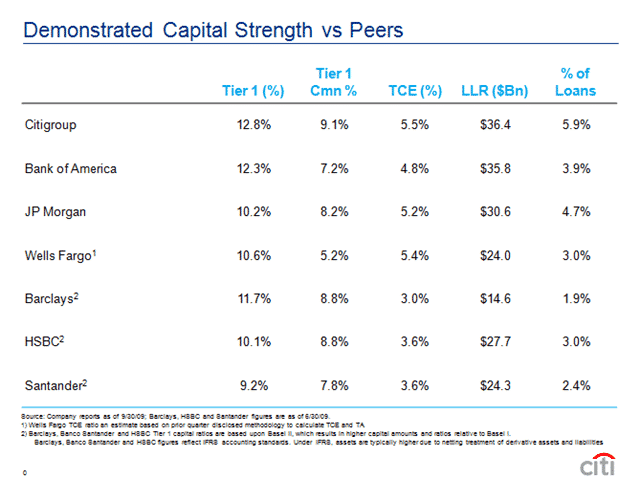How well capitalized is Citigroup?
In a recent post, “How is Citi going to deal with $38 billion in deferred tax assets?,” I pointed to a Reuters article which called into question Citigroup’s ability to earn enough money to prevent its having to take a charge for an incredibly large deferred tax asset. That post generated a response from a Citi representative who emphatically defended Citi’s capital position with a chart comparing Citigroup to other large global financial institutions.
Below is that chart:
As you can see from the chart, based on Citi’s reported public accounts, the company is well-capitalized. Moreover, even hedge fund operators like John Paulson who maid a mint on shorting financials in 2007 and 2008 now think Citi is in much better condition. Paulson was known to be buying shares in August.
You could agree or disagree with Paulson about whether Citigroup is a buy at its present share price. And you could argue that Citi should be taking the charge that Willens suggests. But the fact is, Citi has been recapitalized – at taxpayer expense. And that’s more the point here.
Citigroup has received more money from the government ($45 billion) than any other bank in the U.S., none of which has been paid back. Moreover, the government was forced to not just forgo dividends on its preferreds but also convert these into common equity and provide debt guarantees for the company. Absent government money, Citigroup is the worst capitalized big bank. Absent government money, Citigroup would not exist.
Even still, Citigroup cannot be nearly as profitable as it once was because it has been forced to sell assets in order to achieve its ratios. Yet, it is an organization with almost $1.9 trillion in assets and is certainly still too big to fail.
I see Citigroup as emblematic of the problems we face in dealing with large systemically dangerous institutions. They insist that we return to some semblance of business as usual after they have received massive bailouts without any clear timeline when those monies will be repaid – if ever. Meanwhile, it is far from clear what these institutions would look like if the collateral they put up for loans received from the Federal Reserve and the rest of their assets were marked to market.
I, for one, think the big banks have made it. I said so as far back as April. I may not like the way they have been recapitalized, but I am in little doubt that they have been.
But Citigroup and Bank of America in particular have gotten there with great help from taxpayers. All of the too-big-to-fail financial behemoths exist because of government largesse. That high-level executives of these organizations show little contrition or remorse for having cost our economy tremendously is the saddest part of this crisis.
Disclosure: I have no financial positions in Citigroup or any other financial services company.

Maybe you can help me understand how 1.9 trillion in assets and 32 trillion in derivatives can possibly equate to anything sound or for that matter even worthy of a quote unquote bailout.
IMO they are a dead bank walking.
https://www.occ.treas.gov/ftp/release/2009-34a.pdf Table 3
Ed
Does anything in your post include its SIV(s)?
If not, how would bringing them on balance sheet change things?
Thanks
DoctoRx